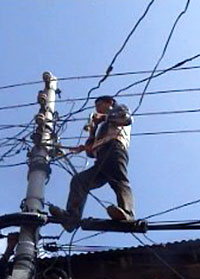 The government is working on a new Electricity Ordinance that will splinter the Nepal Electricity Authority (NEA) into at least three outfits to manage generation, transmission and distribution.
The government is working on a new Electricity Ordinance that will splinter the Nepal Electricity Authority (NEA) into at least three outfits to manage generation, transmission and distribution.
But even NEA insiders are puzzled about why this has become the government's priority at a time when attention should have gone to tackling a looming power shortage, addressing unprecedented losses and launching new projects.
Work on the new ordinance was expedited after the controversial appointment of Harish Chandra Shah as the new director of NEA two months ago. Critics said Shah has no background in the power sector and questioned the timing of his appointment.
It is now looking more and more probable that Shah's appointment and discussions on the new ordinance are linked and aimed at making it easier for favourites to invest in Nepal's power sector through the backdoor.
Senior NEA executives have been kept in the dark about the new ordinance and speculation has grown that the royal regime is eyeing NEA's Rs 60 billion in assets and handing over generation, transmission and distribution to selected partners.
The private sector was asked for suggestions on the electricity ordinance but one source told us its recommendations weren't included in a draft that was finalised at a retreat in Godavari Resort last month. Some private sector producers are said to be in favour of splitting NEA into three components saying it will make the body more efficient.
But at a time when the government is finding it difficult to get international tenders for Kathmandu Valley's water supply management it is doubtful if there will be any takers for private sector involvement in a fragmented electricity utility. NEA insiders point out that private sector competition in the energy sector has rarely worked in countries like Nepal where big capital outlays, huge infrastructure and long construction periods are required. NEA was set up in 1986 under pressure from the World Bank and other donors.
The uncertainty over the future of the NEA comes at a time when the it is preoccupied with a 40 MW shortfall this winter. There is already an unofficial load-shedding in tarai industries. Last year peak demand reached 557 MW in December and this year it will exceed 594 MW. The big question is where the extra power is going to come from when not a single MW has been added.
Except for the 70 MW Middle Marsyangdi which is to come onstream in 2007, there isn't a single big power project that has been launched since King Gyanendra took over three years ago. There hasn't yet been any concern about what project to undertake after Middle Marsyangdi even though load-shedding reminiscent of the last days of the Panchayat are imminent.
In fact, it is looking increasingly like the post-1990 democracy period literally handed power to the people. Successive elected governments in that period liberalised power generation, allowed joint-venture and private sector investment and increased the price of electricity by almost 400 percent to make NEA profitable. Between 1998-2002 NEA was making a profit of up to Rs 1.23 billion a year. But in the years since 2002 NEA has amassed losses of up to Rs 5.39 billion.
Even after 2002, successive water resource ministers appointed by the king have tried to manage prices with differential tariffs and other demand-side interventions but these have been turned down because of feared backlash from the urban middle class.
There is now a real danger that NEA will end up in the same rut as the Nepal Oil Corporation which is facing colossal losses and an inability to pay Indian suppliers because of the lack of political will to raise prices.
Power sector analysts say there is no reason why the country should face a dark winter. There are dozens of power projects where feasibility studies, design and infrastructure are already complete. There is no shortage of domestic and foreign investors. An IPO for the Chilime Project this year expected to raise Rs 240 million ended up raising Rs 1.1 billion just from NEA employees.
If only the government could show more interest, donors, international development banks and overseas Nepalis could step in with extra capital. But instead of trying to build on this promise, analysts say the government is trying to fix what ain't broke with the electricity ordinance.


